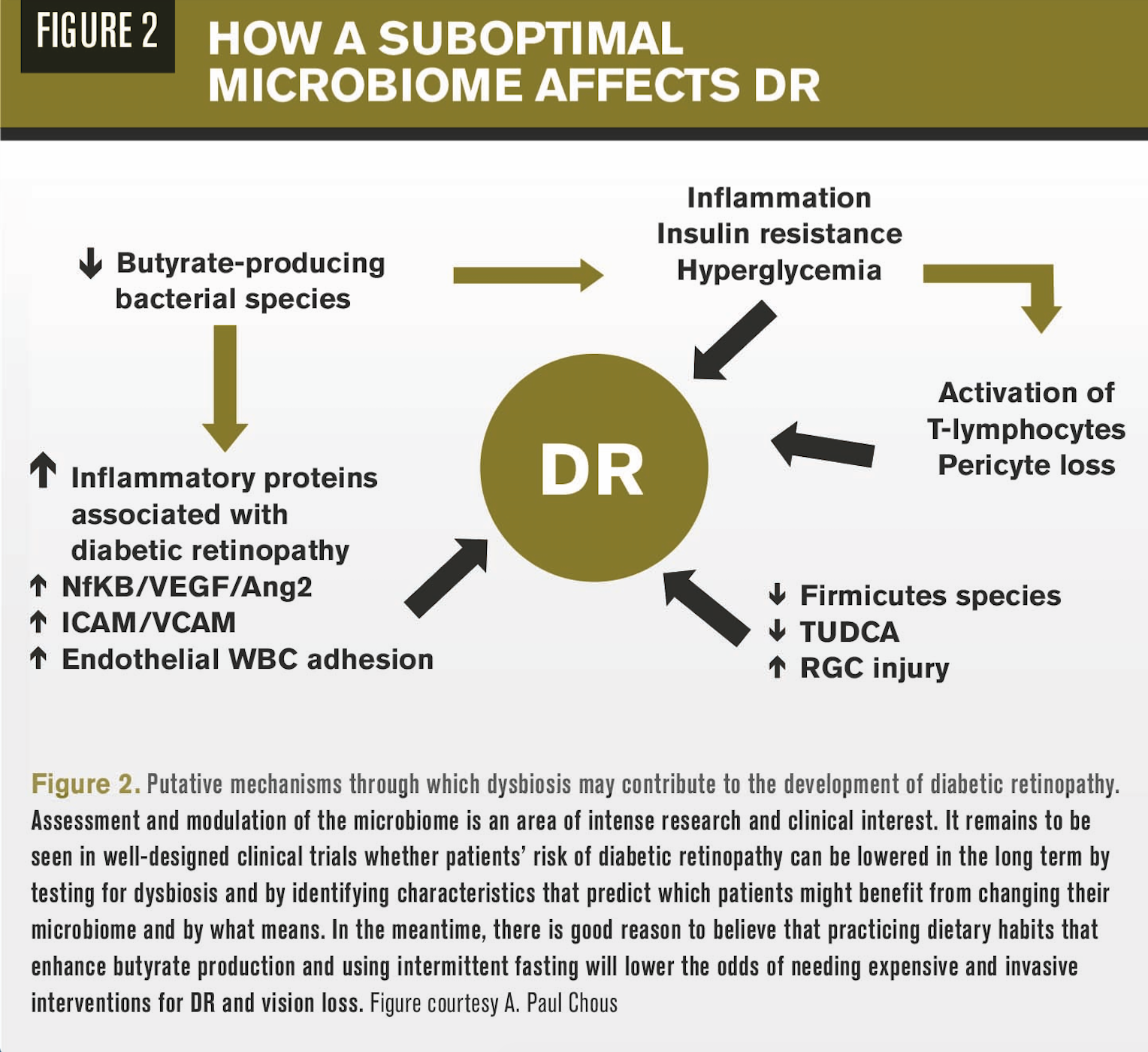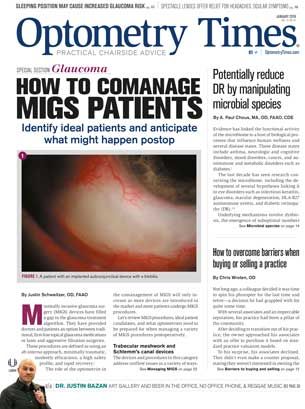How to potentially reduce diabetic retinopathy by manipulating microbial species




The human microbiome refers to a diverse biological ecosystem of microorganisms residing within-and on the surface of-human beings.
It consists of roughly 100 trillion commensal, symbiotic, and pathogenic microbial cells housed primarily within the gastrointestinal tract, including bacteria, fungi, and viruses. Microbial cells living within and on us outnumber human cells 3 to 1.
These species contain up to 10 million nonredundant genes compared to 23,000 human genes, a ratio of almost 500 to 1.1
Read more about diabetic retinopathy
Although each of us is about 99.9 percent identical genetically, our individual microbiome may be up to 90 percent dissimilar given variations in diet, lifestyle, and gene mutations. These directly influence microbiome’s composition and function or expression of genes encoded within that microbial universe.
Underlying factors
Evidence has linked the functional activity of our microbiome to a host of biological processes that influence human wellness and several disease states, including asthma, neurologic and cognitive disorders, mood disorders, cancer, and autoimmune and metabolic disorders such as diabetes.2
The last decade has seen research concerning the microbiome, including the development of several hypotheses linking it to eye disorders like infectious keratitis, glaucoma, macular degeneration, HLA-B27 autoimmune uveitis, and diabetic retinopathy (DR).3-5
Underlying mechanisms involve dysbiosis, the emergence of suboptimal numbers and/or ratios of microbial species that leads to inflammation, loss of normal immune regulation, disease and/or metabolic defects.
Treatment
Evidence suggests that people with both type 1 and type 2 diabetes have reduced butyrate-producing intestinal flora,6 and that restoration of healthy butyrate production is possibly via the following:
• Changing diet (increased fiber and fermented foods
• Reducing dietary saturated/trans fat and glycemic index
• Avoiding non-nutritive sweeteners like aspartame/sucralose/saccharin)7
• Using prebiotic/probiotic supplements8
• Considering fecal microbiota transplantation (FMT)
Avoiding artificial sweeteners, adding probiotics, and FMT from lean/healthy donors can temporarily improve blood glucose in animal and some human models.9
Related: When to refer patients with diabetic retinopathy
Metformin, the most commonly prescribed medicine for type 2 diabetes, has been shown to increase butyrate-producing flora,10 as have fasting11 and Roux-en Y gastric by-pass surgery.12
The link between gut dysbiosis and the development of diabetes is illustrated in Figure 1.
Experimentation
Significant reduction of DR lesions (pericyte ghosts and capillary leukocyte adhesion) was recently demonstrated in a mouse model using intermittent fasting with modulation of the gut microbiome.5
Mice with diabetes were fed an ad libitum diet or were fasted for 24 hours every other day for seven months.
Intermittent fasting (IF) increased firmicutes species, resulting in production of favorable bile acids by the liver.
Those bile acids changed into tauroursodeoxycholate (TUDCA), a neuroprotective “secondary bile acid” that enters systemic circulation and crosses the blood-brain and blood-retina barriers. TUDCA also activated receptors on the surface of retinal ganglion cells.
Though the animals in the two feeding groups had no difference in blood glucose levels, retinopathy lesions were nearly eliminated in the fasting group. When a synthetic analog for the TUDCA receptor was given to another group of diabetic mice, they also developed minimal DR lesions.
Related: New strategies to assess the risk of diabetes-related vision loss
This study demonstrates that intermittent fasting may have the potential to reduce DR severity in humans independently of hyperglycemia by altering the microbiome.
Fasting benefits
Another mechanism through which fasting might benefit DR is via enhanced numbers of butyrate-producing bacterial species.
Butyrate has been shown to inhibit production of inflammatory cytokines implicated in the development of DR (VEGF, Ang2, ICAM-1, VCAM-1, TNF-α
and hsCRP).13,14
Analysis of food frequency surveys showed a significant association among lower fiber intake and higher fatty acid intake with DR risk. Both of these dietary features have been directly linked to both dysbiosis and endotoxemia.
Activation of T-lymphocytes by gut bacteria has also been implicated in pericyte destruction underlying DR.
This suggests that selective antibiotics could be deployed to reduce DR analogously to the successful use of targeted antibiotics, to reduce the incidence and severity of HLA-B27 mediated uveitis.14-16
Various pathways through which a suboptimal microbiome might augment the pathogenesis of diabetic retinopathy are illustrated in Figure 2.
References:
1.Cho I, Blaser MJ. The human microbiome: at the interface of health and disease. Nat Rev Genet. 2012;13(4):260-70.
2. Liang D, Leung RK, Guan W, Au WW. Involvement of gut microbiome in human health and disease: brief overview, knowledge gaps and research opportunities. Gut Pathog. 2018;10:3.
3. Lu LJ, Liu J. Human microbiota and ophthalmic disease. Yale J Biol Med. 2016;89(3):325-330. 2016 Sep 30;89(3):325-330.
4. Zárate-Bladés CR, Horai R, Caspi RR. Regulation of autoimmunity by the microbiome. DNA Cell Biol. 2016 Sep;35(9):455-8.
5. Beli E, Yan Y, Moldovan L, Vieira CP, Gao R, Dyan Y, Prasad R, Bhatwadekar A, White FA, Townsend SD, Chan L, Ryan CN, Morton D, Moldovan EG, Chu FI, Oudit GY, Derendorf H, Wang XX, Evans-Molina C, Mirmira RG, Boulton ME, Yoder MC, Li Q, Levi M, Busik JV, Grant MB. Restructuring of the gut microbiome by intermittent fasting prevents retinopathy and prolongs survival in db/db mice. Diabetes. 2018 Sep;67(9):1867-1879.
6. Aydin Ã, Nieuwdorp M, Gerdes V. The gut microbiome as a target for the treatment of Type 2 diabetes. Curr Diab Rep. 2018 Jun 21;18(8):55. doi: 10.1007/s11892-018-1020-6.
7. Singh RK, Chang HW, Yan D, Lee KM, Ucmak D, Wong K, Abrouk M, Farahnik B, Nakamura M, Zhu TH, Bhutani T, Liao W. Influence of diet on the gut microbiome and implications for human health. J Transl Med. 2017 Apr 8;15(1):73.
8. Hu YM, Zhou F, Yuan Y, Xu YC . Effects of probiotics supplement in patients with type 2 diabetes mellitus: A meta-analysis of randomized trials. Med Clin (Barc). 2017 Apr 21;148(8):362-370.
9. Kootte RS, Levin E, Salojärvi J, Smits LP, Hartstra AV, Udayappan SD, Hermes G, Bouter KE, Koopen AM, Holst JJ, Knop FK, Blaak EE, Zhao J, Smidt H, Harms AC, Hankemeijer T, Bergman JJGHM, Romijn HA, Schaap FG, Olde Damink SWM, Ackermans MT, Dallinga-Thie GM, Zoetendal E, de Vos WM, Serlie MJ, Stroes ESG, Groen AK, Nieuwdorp M. Improvement of insulin sensitivity after lean donor feces in metabolic syndrome is driven by baseline intestinal microbiota composition. Cell Metab. 2017 Oct 3;26(4):611-619.e6
10. Wu H, Esteve E, Tremaroli V, Khan MT, Caesar R, Manneras-Holm L, Stahlman M, Olsson LM, Serino M, Planas-Felix M, Xifra G, Mercader JM, Torrents D, Burcelin R, Ricart W, Perkins R, Fernandez-Real JM, Backhed F. Metformin alters the gut microbiome of individuals with treatment-naive type 2 diabetes, contributing to the therapeutic effects of the drug. Nat Med. 2017 Jul;23(7):850-858.
11. Li G, Xie C, Lu S, Nichols RG, Tian Y, Li L, Patel D, Ma Y, Brocker CN, Yan T, Krausz KW, Xiang R, Gavrilova O, Patterson AD, Gonzalez FJ. Intermittent Fasting promotes white adipose browning and decreases obesity by shaping the gut microbiota. Cell Metab. 2017 Oct 3;26(4):672-685.e4
12. Peat CM, Kleiman SC, Bulik CM, Carroll IM. The intestinal microbiome in bariatric surgery patients. Eur Eat Disord Rev. 2015 Nov;23(6):496-503
13. Zapolska-Downar D, Siennicka A, Kaczmarczyk M, Kolodziej B, Naruszewicz M. Butyrate inhibits cytokine-induced VCAM-1 and ICAM-1 expression in cultured endothelial cells: the role of NF-kappaB and PPARalpha. J Nutr Biochem. 2004 Apr;15(4):220-8.
14. Fukae J, Amasaki Y, Yamashita Y, Bohgaki T, Yasuda S, Jodo S, Atsumi T, Koike T. Butyrate suppresses tumor necrosis factor alpha production by regulating specific messenger RNA degradation mediated through a cis-acting AU-rich element. Arthritis Rheum. 2005 Sep;52(9):2697-707.
15. Nayak RC, Agardh CD, Kwok MG, Stjernquist H, Farthing-Nayak PJ, Agardh E. Circulating anti-pericyte autoantibodies are present in Type 2 diabetic patients and are associated with non-proliferative retinopathy. Diabetologia. 2003 Apr;46(4):511-3. Epub 2003 Mar 13.
16. Nakamura YK, Metea C, Karstens L, Asquith M, Moscibrocki C, Lee I, Brislawn CJ, Jansson JK, Rosenbaum JT, Lin P. Gut microbial alterations associated with protection from autoimmune uveitis. Invest Ophthalmol Vis Sci. 2016 Jul 1;57(8):3747-58.

Newsletter
Want more insights like this? Subscribe to Optometry Times and get clinical pearls and practice tips delivered straight to your inbox.